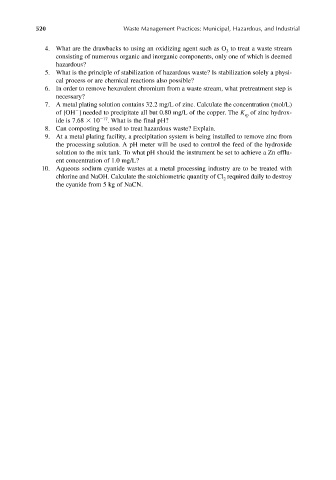Page 549 - Materials Chemistry, Second Edition
P. 549
CAT3525_C16.qxd 1/27/2005 12:42 PM Page 520
520 Waste Management Practices: Municipal, Hazardous, and Industrial
4. What are the drawbacks to using an oxidizing agent such as O to treat a waste stream
3
consisting of numerous organic and inorganic components, only one of which is deemed
hazardous?
5. What is the principle of stabilization of hazardous waste? Is stabilization solely a physi-
cal process or are chemical reactions also possible?
6. In order to remove hexavalent chromium from a waste stream, what pretreatment step is
necessary?
7. A metal plating solution contains 32.2 mg/L of zinc. Calculate the concentration (mol/L)
of [OH ] needed to precipitate all but 0.80 mg/L of the copper. The K of zinc hydrox-
sp
ide is 7.68 10 17 . What is the final pH?
8. Can composting be used to treat hazardous waste? Explain.
9. At a metal plating facility, a precipitation system is being installed to remove zinc from
the processing solution. A pH meter will be used to control the feed of the hydroxide
solution to the mix tank. To what pH should the instrument be set to achieve a Zn efflu-
ent concentration of 1.0 mg/L?
10. Aqueous sodium cyanide wastes at a metal processing industry are to be treated with
chlorine and NaOH. Calculate the stoichiometric quantity of Cl required daily to destroy
2
the cyanide from 5 kg of NaCN.

